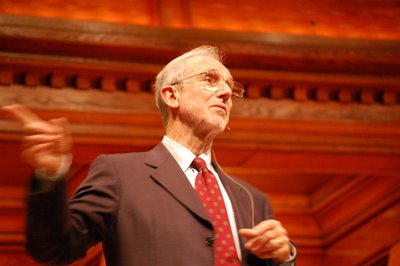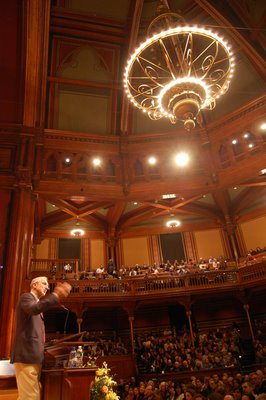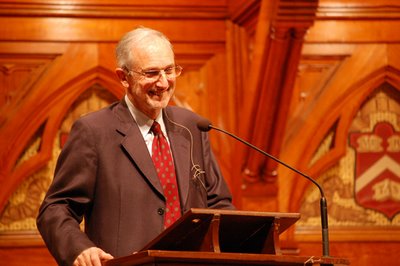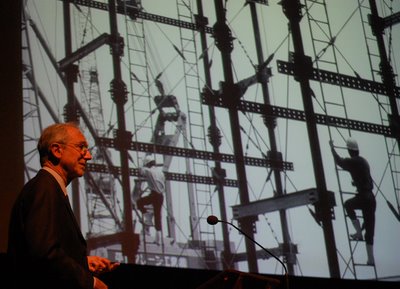Renzo Piano speaks at Harvard

At Harvard’s Sanders Theatre last night, Renzo Piano spoke about the many buildings he has designed over the years. Of late, the Italian architect has developed or is developing plans for renovating and expanding Harvard Art Museum, for expanding and renovating the Gardner Museum, and for Harvard’s expansion into Allston. Piano briefly mentioned these projects ("Don't worry, we're not touching [Gardner's] palace. The palace is great. The palace is magic.") but revealed nothing particularly newsworthy. Here are some excerpts from his talk:
• “When you work on a creative job, you have to be brave enough to watch in the dark for a while.”
• “I wanted to be a musician myself, but I wasn’t good enough. So I decided to be an architect.”
• On designing the Centre Pompidou in Paris: “I still don’t understand how people allow us to do this in the middle of Paris.”
• “Light is one of the most important materials of architecture.”
• “Natural light is a place where you can feel the clouds passing by, the day going away. It’s essential.”
 • “Architects are a bit like fishermen – you never catch the fish you want to catch.”
• “Architects are a bit like fishermen – you never catch the fish you want to catch.”• “The airport is like a cathedral. … The railway station has always been a place of mythology, not just pragmatical.”
• “It’s essential for people to understand that mistakes are important.”
• Berlin: “It’s a city suspended between nostalgia and pride. It was a city that was hurted, immensely hurted by the war.”
• “In Berlin, we found bombs in the ground that did not explode. The Germans say, ‘Thank God they were Russian so they did not explode.’”
• “Transparency is still a very important quality of urban life. … Urbanity comes because the buildings talk to the street.”
• “The art of listening is the most difficult thing to teach people.”
• “Listening doesn’t mean you have to be more obedient.”
• “Making interesting shapes is not very difficult. What is more difficult is to make shapes that make sense, that are buildable.”
• “Transparency is a constant struggle for me. I think transparency between the inside and the outside is a way to be not selfish.”

• On designing the New York Times Building: “It was the first big building, skyscraper, [built in New York] after Sept. 11. … We decided that transparency is more safe than opacity. … After Sept. 11 everybody wanted to make buildings that were like bunkers.”
• “I believe more and more that architecture should recognize that the world is fragile.”
• “We have to be wise. So we should make buildings that consume less electricity. We need to invent an architecture for the 21st century. … We have to invent an architecture that breathes, that has a dialogue with the world, with the environment.”
• “This may be a European idea – by doing something new you don’t have to destroy what is already there. Architecture is like making layers.”

• “Buildings really should be loved [by the people who use them].”
• “Architecture is about fighting against gravity. Think about it: gravity is a very stubborn force of nature.”
• “Architecture is about rebellion. You always have to look for Atlantis. You always have to believe in changing the world.”
Photos by The New England Journal of Aesthetic Research.








0 Comments:
Post a Comment
<< Home